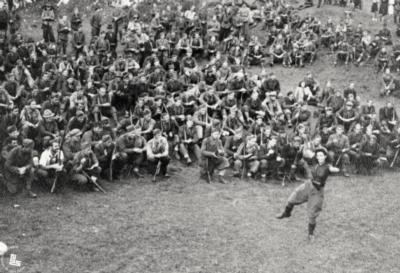Brina, the contemporary dancer

On the evening of September 8, 1943, an Italian soldier in the guardhouse of the concentration camp Rab (northern Adriatic) shouted: “The war is over, let’s go home!” Some soldiers have left the camp, and after a rally in the so-called Hunger Square, the inmates disarmed and captured the remaining guards.
About 1,750 of the approximately 5,000 former camp inmates organized themselves into a Rab Brigade that contained five battalions and a headquarters. After being transported to the mainland, part of the brigade members went to Banija (central Croatia), and part to southern Slovenia (while the partisans forces of Croatia deployed most of the others in the partisan-held territories).
When the members of the Rab Brigade arrived at the hamlet of Mašun in Slovenia, they took an oath of allegiance before a military priest of the XIV division. The ceremony was accompanied by the program performed by the cultural group led by the poet Karel Destovnik - Kajuh.
For a couple of weeks, since the very end of August, contemporary dancer Marta Paulin - Brina was part of Kajuh’s cultural group. She greeted the fighters of the Rab Brigade with a “battle dance”, and they accompanied her dance with clapping and singing.
The circumstances of war changed quickly.
Most members of the Rab Brigade were too weak to fight. The former detainees were soon after deployed in smaller numbers to other units. And Brina’s partisan dance performances ended with the march of the XIV division to Styria in January and February 1944. Due to inappropriate footwear and very cold winter weather, she got frostbite on her legs. Although she avoided amputation, she could no longer dance.
Recalling her short partisan dance career, Brina primarily remembered that unique combination of hope, conviction, joy and togetherness that were a part of her partisan experience:
... it was a dance expression rooted in the soil of the home, in a person’s participation in the historical events of their people. In the participation in the liberation struggle of a people who do not know despair, who are aware of their power and their mission. Dance calls for battle, wins in battle; it evolves into joy: because of the struggle, because of the endured efforts, because of the power, because of the historical act itself. In this dance circle, we gave each other our hands. Our circle was firmly closed: with effort and suffering, amid gasps and smiles. As a dancer, standing alone among a crowd of fighters with the awareness that I would be able to express with my dance talent and weak body what united us, that I would be able to master the immense space of nature, I felt strength in my legs as I stomped hard earth. The hands felt the extent of the woods and climbed over the treetops.
Jože Javoršek (partisan, but not a member of the Rab Brigade) testified that Brina’s dance was indeed a unique sight:
I will never forget Brina how she danced to the sounds of the wind and the rustling of branches, to the chirping of birds and to the rhythm produced by the quiet breathing of the earth.
Author of the photograph: Jože Petek, Slovenian partisan and war photo reporter (1912 - 1945)
Owner of the photograph: Muzej novejše zgodovine Slovenije (Museum of Contemporary History of Slovenia), Ljubljana, Slovenia
Selected reading:
Komelj, Miklavž. Kako misliti partizansko umetnost? (How To Think Partisan Art?) Ljubljana: Založba /*cf, 2009.
Milohnić, Aldo. Gledališče upora (Theather of Resistance). Ljubljana: Akademija za gledališče, radio, film in televizijo Univerze v Ljubljani, 2021.
Paulin-Brina, Marta. “Plesna umetnost v partizanih” (“Dance Art in the Partisans”). In Partizanska umetnost (Partisan Art), edited by Filip Kalan et al., 20-27. Ljubljana: Zveza kulturno-prosvetnih organizacij Slovenije / Delavska enotnost, 1975).
